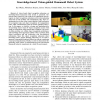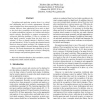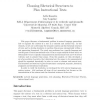727 search results - page 66 / 146 » Planning motions with intentions |
ICMI
2005
Springer
14 years 1 months ago
2005
Springer
Situated, spontaneous speech may be ambiguous along acoustic, lexical, grammatical and semantic dimensions. To understand such a seemingly difficult signal, we propose to model th...
IROS
2007
IEEE
14 years 2 months ago
2007
IEEE
— A vision based object recognition subsystem on knowledge-based humanoid robot system is presented. Humanoid robot system for real world service application must integrate an ob...
ACSAC
2004
IEEE
13 years 11 months ago
2004
IEEE
Correlating and analyzing security alerts is a critical and challenging task in security management. Recently, some techniques have been proposed for security alert correlation. H...
AAAI
2008
13 years 10 months ago
2008
In order to interact successfully in social situations, a robot must be able to observe others' actions and base its own behavior on its beliefs about their intentions. Many ...
CI
2000
13 years 7 months ago
2000
This paper discusses a fundamental problem in natural language generation: how to organize the content of a text in a coherent and natural way. In this research, we set out to det...



